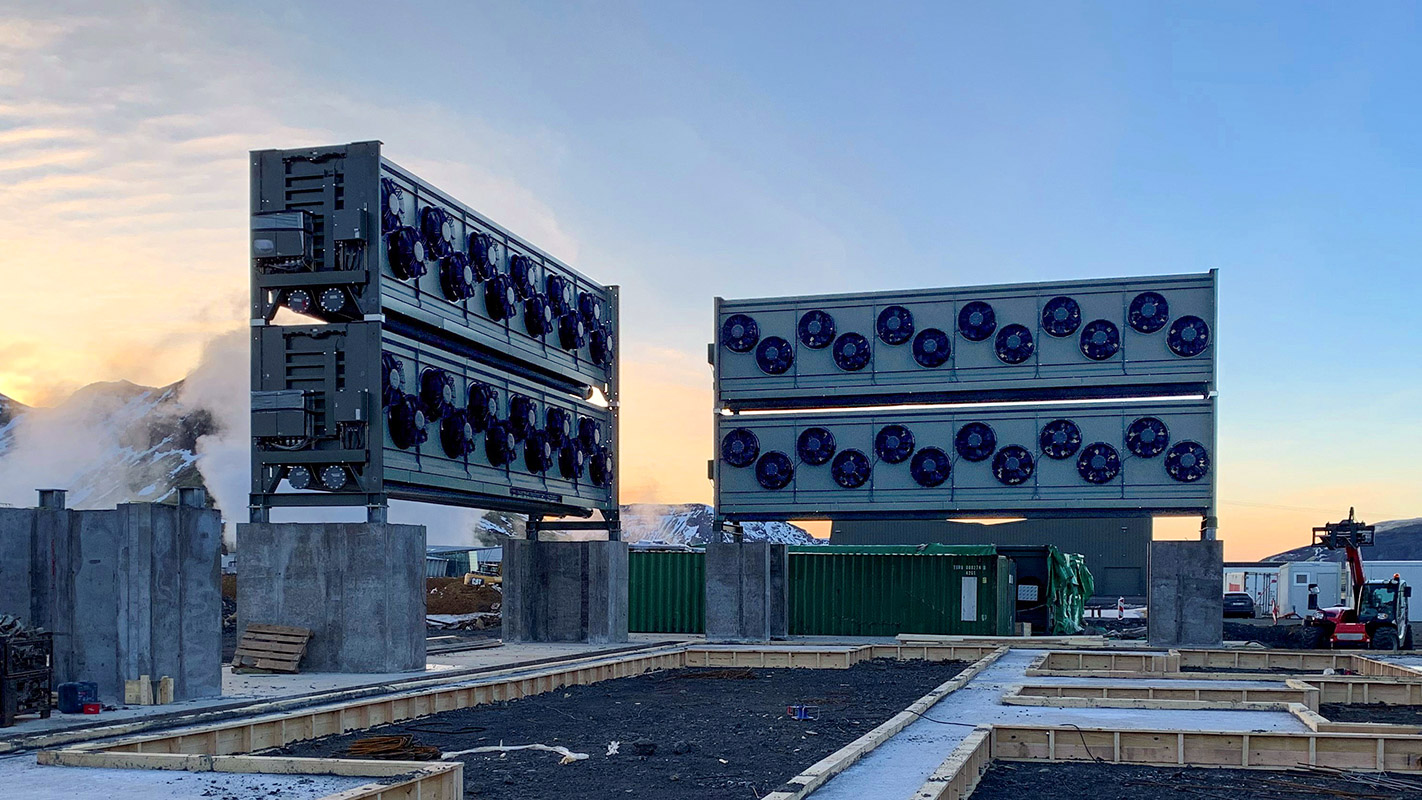2023 Climate Tech Companies to Watch: Climeworks and its carbon-sucking fans
Companies are paying Climeworks to turn carbon pollution into rocks.

Explore the 2023 list of 15 Climate Tech Companies to Watch.
To prevent catastrophic global warming, we must remove carbon dioxide from the atmosphere in addition to eliminating fossil fuels. Climeworks is pioneering one of the most promising approaches: direct air capture, in which giant machines suck carbon out of the sky.
Intro
More than any other company, Climeworks is putting direct air capture (DAC) on the map.
Climate models indicate that to cap global warming at well below 2 °C over preindustrial levels, we’ll need to remove gigatons, or billions of tons, of carbon dioxide from the atmosphere. Carbon-scrubbing machines are an attractive option for doing so because they require far less land than natural solutions like reforestation, and you can more reliably measure how much greenhouse gas is sequestered. But today, so-called DAC technology is in its infancy.
Climeworks is among the first companies to try to commercialize it. Using air collectors that draw carbon in and trap it on specialized filters, Climeworks is building modular and scalable DAC plants powered by renewable energy. In 2017, the company opened the world’s first commercial DAC plant in Switzerland, which sold captured carbon to customers like Coca-Cola. In 2021, Climeworks launched Orca, the first commercial DAC plant to capture carbon and store it permanently underground, in partnership with Carbfix.
Earlier this year, Climeworks provided the world’s first carbon removal services using DAC to Microsoft, Shopify, and Stripe.
Key indicators
- Industry: Carbon removal
- Founded: 2009
- Headquarters: Zurich, Switzerland
- Notable fact: Before Climeworks was sending captured carbon underground for storage, the company was using it to grow tomatoes and cucumbers at a greenhouse near the company’s first commercial plant in Hinwil, Switzerland.
Potential for impact
If widely deployed, DAC technology could permanently reduce atmospheric CO2 levels, by pulling gigatons of carbon out of the air and piping it into underground reservoirs where it is incorporated into rocks.
Through its first commercial plants, Climeworks is doing the early learning necessary for DAC to eventually reach gigaton scales. It’s also demonstrating that the DAC process can be climate friendly. Unlike other flavors of DAC, in which fossil fuels are burned to produce the heat needed to release captured CO2 from a liquid solvent so that it can be stored, Climeworks uses a low-temperature approach that runs entirely on renewable energy.
And while some companies want to use carbon captured via DAC to pump more oil out of wells (a controversial process known as enhanced oil recovery), Climeworks is permanently storing the greenhouse gas underground.
Caveats
Still, both high- and low-temperature DAC require large amounts of energy to suck comparatively tiny amounts of carbon out of the atmosphere. This, along with the high up-front cost of building DAC plants, makes the technology expensive. Cost estimates for DAC vary widely, ranging from $200 to more than $1000 per ton of CO2 removed today. Climeworks offered its first customers a sale price of approximately $800 per ton of CO2 removed.
For DAC to reach its full potential, the cost needs to drop significantly. The US government is eyeing a long-term cost target of $100 per ton of CO2 removed, and it’s making investments and offering tax credits to help drive costs down. But a recent study found that even if the industry were operating at gigaton scales, reaching $100 a ton would be very challenging.
When
Climeworks is operating on a small scale today: its Orca plant in Hellisheidi, Iceland, can remove up to 4,000 metric tons of CO2 from the atmosphere each year. But its growth plans are ambitious. Within the next year, it expects to finish construction of its second DAC-plus-storage facility, called Mammoth. Also located in Iceland, Mammoth should have the capacity to pull up to 36,000 metric tons of CO2 from the atmosphere each year.
From there, Climeworks plans to go even bigger. By 2030, the company aims to remove more than a million tons of carbon from the atmosphere each year. To reach that goal, it plans to launch several commercial DAC projects in the US and other countries in the coming years.
Next steps
To build confidence in its technology, Climeworks must continue to deliver on its early contracts and grow its customer base. The company will likely announce additional carbon deliveries, and more carbon removal contracts, in the coming months and years. In August, the US Department of Energy Funding selected three projects Climeworks is involved with to receive funding under the agency’s Regional DAC Hubs program. Last month, Climeworks announced that it was exploring potential direct air capture and storage projects in Kenya.
Ultimately, whether Climeworks meets its goals will depend on whether it can offer carbon removal services at a lower cost than companies developing competing DAC technology, and whether the overall costs of DAC can be brought down. Several nations are now offering financial incentives for DAC, but more governmental assistance will be required to reach optimistic cost targets.
Explore the 2023 list of 15 Climate Tech Companies to Watch.
Deep Dive
Climate change and energy

This rare earth metal shows us the future of our planet’s resources
The story of neodymium reveals many of the challenges we’ll likely face across the supply chain in the coming century and beyond.

Andrew Ng’s new model lets you play around with solar geoengineering to see what would happen
The climate emulator invites you to explore the controversial climate intervention. I gave it a whirl.

Want to understand the future of technology? Take a look at this one obscure metal.
Here’s what neodymium can tell us about the next century of material demand.
Stay connected
Get the latest updates from
MIT Technology Review
Discover special offers, top stories, upcoming events, and more.
